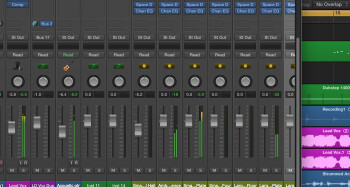So far we have reviewed quite extensively the "classic" uses of reverb during mixdown, but I would now like to invite you to discover more exotic applications in the next couple of articles. These are obviously not techniques you should apply systematically on each song, but used wisely they can certainly spice up somewhat dull productions.
What goes around comes around
I’m writing this early in the morning after a sleepless night, so please bear with me. Would you believe me if I were to tell you that there’s a way to automatically give a sense of movement and depth to any instrument in no time? Well, you should! And the best thing about it is that it’s really easy to achieve. Allow me to use an example to explain myself better.
Imagine a vocal track. At this point it should already be properly EQed and compressed. Now, create an aux bus and insert a reverb in it. Choose a preset that gives the impression of remoteness to any element sent to the reverb. Next, send your vocal track pre-fader and, if possible, pre-insert. If your DAW doesn’t have a specific “pre-insert” setting, you can get the same effect with either of the following methods:
- Duplicate the track without the effects, don’t send it to the master bus, but feed the reverb with it.
- Send the track to a bus which has all the insert FX you want, cut the original track from the master, and send the original track to the reverb.
But what’s the point, you ask? Well, if you take the signal pre-insert, the vocals can be processed with the reverb before it is compressed. The result is that the original dynamics of the signal will make the reverb level vary naturally. Thus, when the level of the vocals is high, the level of the reverb will also be high and the listener will be under the impression that the singer is moving away from him. Inversely, when the level is weak, the reverb will be extremely discreet, which will give the illusion of closeness. Isn’t life nice?
I obviously recommend you to fine tune the outcome by carefully adjusting the send level towards the reverb. And don’t forget to EQ the reverb’s aux bus to avoid any frequency masking.
Do note that even if I used the example of a vocal track, this trick will work just as well on any other instrument. However, this technique is usually applied to solo instruments. Having the bass, rhythm guitar or drums move back and forth in the mix isn’t probably the best idea. In fact, it could be counterproductive since these are the instruments that make up the foundations of your song.
Next time we’ll see a similar trick, but focusing on how to create the illusion of lateral movement.

